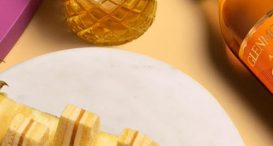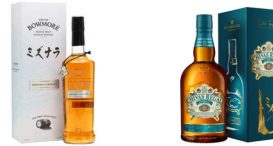The Return of the Blend
let’s begin
Blends used to be the King of the Whisky world. So much so that the thought of a successful single malt was scoffed at.
But those days are past and the blend now has to share its platform with a range of Whisky categories, with many believing single malt to be the best.
Single malt is one of the most talked about categories, especially among Whisky drinkers themselves, but blends are still the biggest sellers.
Johnnie Walker, Chivas Regal and Ballantine’s are some of the biggest selling Whiskies in the world, and continually pop up in best sellers lists. They are known globally as the biggest names in Whisky.
There are also countless independent blenders producing some incredible drams. Douglas Laing, Whyte & Mackay and Gordon & MacPhail are all big names within the industry and have created award-winning blends alongside their single malt ranges.
What is a blend exactly?
A blend is exactly what it says on the tin. It is a mix of many different grains and malts from many different distilleries.
It is made up of grain and malt whiskies, with the grain being used to bolster the flavour. While they do not givethe blend depththemselves, they allow the malts to bounce off them, revealing the depths of the malts.
They act as a softer background for the rich and complex malts to show themselves, rather than overpowering them with more and more malts.
They also make blends less pricey than their single malt counterparts as grain Whiskies are cheaper to produce since their ingredients are more readily available and not as dear as barley.
The use of grain Whiskies also make blends an easy target for critics who regard them as cheap, but the grain actually contributes to the flavour by making it better, not worse. This is because it acts as a foundation, allowing the complexities of the malts to be accented against a softer background.
So grain Whiskies may not be as intricate, but they act as a sort of sounding board for the malts to shout against, so they can be heard in all their glory.
What makes blends so different?
Blends differ from single malts mainly because they need to be tasted constantly throughout the blending process to ensure there is consistency and that the different Whiskies all work together.
They are the result of years of craftsmanship and dedication.A master blender does not simply wake up one day with a profound ability to create a cohesive and enjoyable liquid.
This skill takes years to refine, just as a master distiller must carefully hone his skills at tasting, and is vital to the creation of both blends and single malts.
From nosing the liquid to working out quantities of each different grain and malt to go into the blend, a master blender can take years, if not decades, to train.
Like a master distiller, they must have a good nose, to be able to work out all the different flavours and tasting notes that will contribute to the final product.
A master blender must make sure that each flavour will work together and make the final product perfect.
This makes them time consuming to make and a lot of skill is needed. If anyone ever asks why distilling is called an art, it’s because creating blends requires creativity and ability.
What makes a good blend?
Consistency is a pretty big one here.
Achieving consistency with single malts can be hard enough, but with blends the level of difficulty rises with the number of barrels.
Wooden casks are so easily influenced by their surroundings, including air and weather, that it can be hard to reproduce the same liquid every time.
It is up to a master blender to go through every cask and ensure that each is consistent with the last.
This can be harder for bigger brands, as they attempt to deal with huge global demand for the same liquid.
Bigger brands also face the threat of shortages. Since Whiskies need to be matured for a certain number of years, a sudden rise in demand can easily lead to a shortage.
This is made even more complicated for blends, since liquids of varying ages are used, so each Whisky, no matter what the age must be fully mature, whether that be for 12 or 25 years, before it can be used in a blend.
This can therefore cause a shortage as blenders are waiting on certain Whiskies maturing.
It means they must be careful about maintaining adequate levels of each different Whisky needed in a blend so the blend can still be made while more Whisky matures.
These things can be overcome with some foresight and a damn good master blender.
But it is not just big names that make great blends. Brands like Compass Box and Monkey Shoulder are some of the best blends available yet they don’t have the same market share as blends such as Johnnie Walker or Chivas Regal.
These are both blends that are very popular, but not as well known as they perhaps should be.
Monkey Shoulder is owned by William Grant & Sons and is a combination of Grant’s three dufftown distilleries, Glenfiddich, Balvenie and Kininvie.
It is an incredibly mellow dram with a creamy mouth feel. Even better, it is fantastic value for money.
Compass Box is an independent blend that was started by John Glaser in 2000. This brand is in it for the product, with complete dedication to creating amazing blends.
This really shows in their exceptional products, that may not have knocked the big brands off the top of the market, but certainly pose a challenge.
These are wonderfully created Whiskies, with dedication and history behind them. They may not be the biggest selling brands, but they are definitely some of the best tasting.
There are plenty of little blends out there and if you perhaps take a look away from single malts and big name blends, then you might just find your new favourite.















2 thoughts on “The Return of the Blend”
Great read! I just tried Shackleton as I was drawn to the “history” behind it. I was pleasantly surprised! I don’t really like blended malts, but this one was superb! For the money ($34 US), It has become a regular addition to my bar. Absolutely wonderful blended malt. I would put it up against many of the 10 & 12 year single malts any day. Those will cost you on average $50-$70 US. If you haven’t tried it, give it a go!